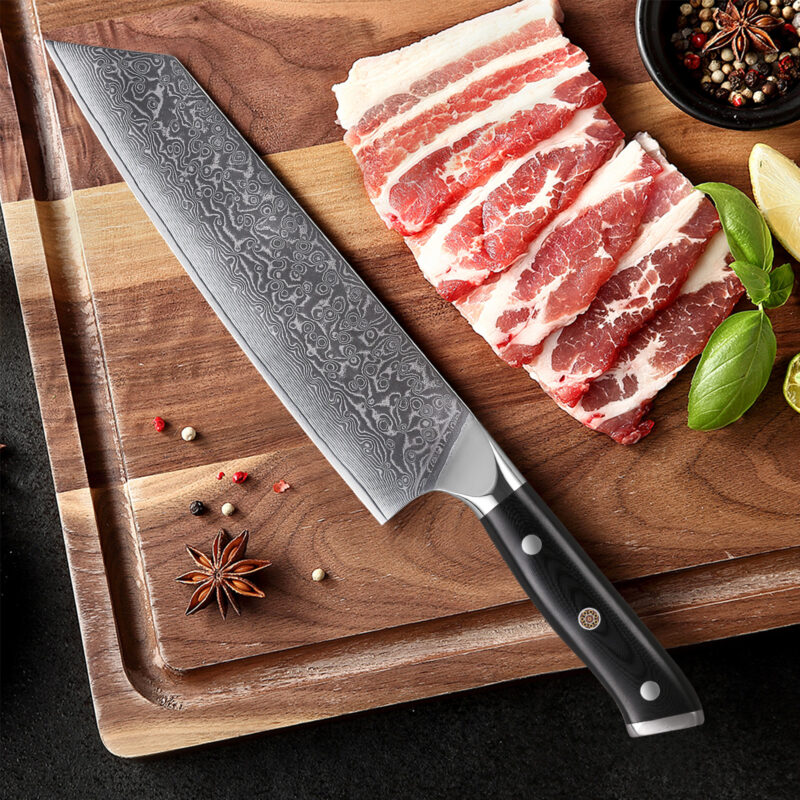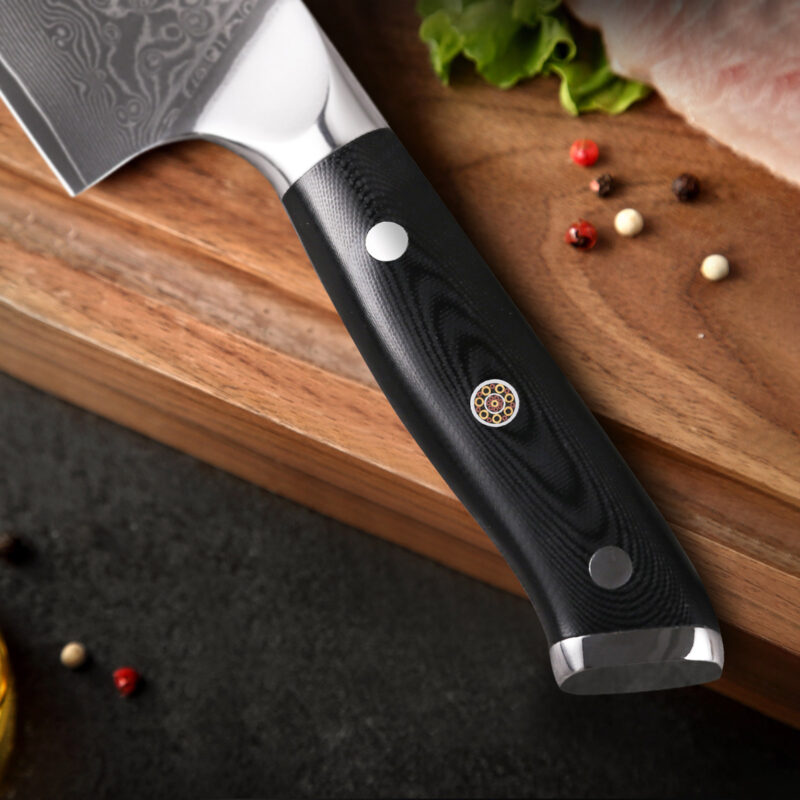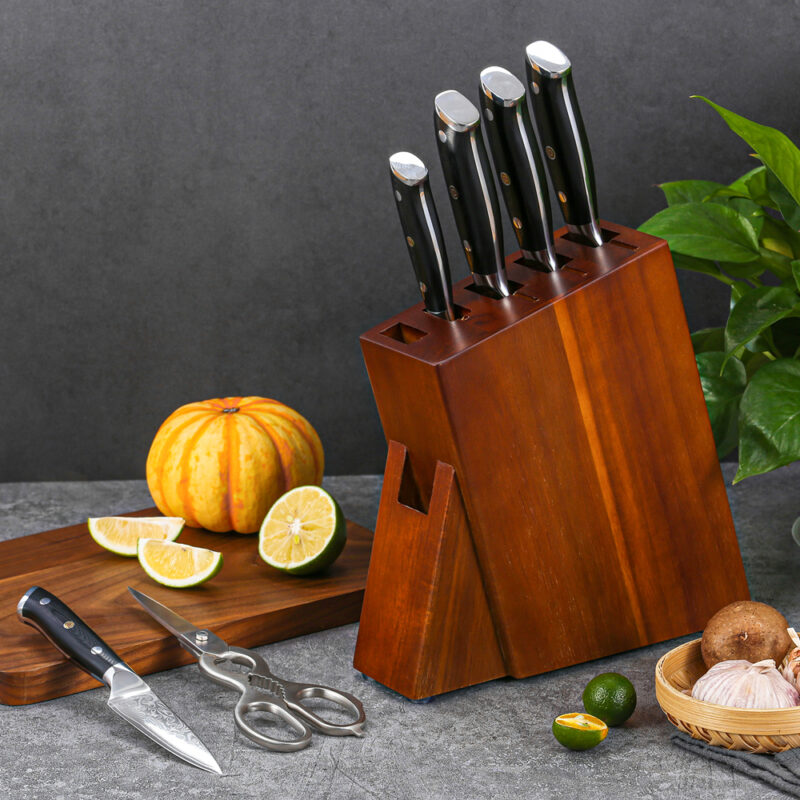Chef's Knives
The Perfect Gift for Your Culinary Crusader: A VG10 Steel Kitchen Knife with Black G10 Handle
A VG10 Steel Kitchen Knife with Black G10 Handle
Are you on the hunt for a unique and thoughtful gift for your culinary-loving boyfriend? Look no further! We’ve got the perfect recommendation that will surely impress him: a kitchen knife made from VG10 steel with a sleek black G10 handle. In this blog post, we’ll delve into the remarkable qualities of VG10 steel and G10 handles, and why this knife makes an exceptional choice for any aspiring or seasoned chef.

- Unveiling VG10 Steel: The Epitome of Sharpness and Durability
VG10 steel is renowned for its exceptional performance in the kitchen. It’s a premium Japanese stainless steel that boasts impressive qualities. With a high carbon content, VG10 steel offers remarkable sharpness, allowing effortless slicing, dicing, and chopping. Your boyfriend will appreciate the precision and efficiency that this knife delivers, making his cooking experience a breeze. Moreover, VG10 steel’s excellent edge retention ensures long-lasting sharpness, reducing the need for frequent sharpening. - The Allure of a Black G10 Handle: Style Meets Functionality
Now, let’s talk about the sleek black G10 handle that encompasses both style and functionality. G10 is a fiberglass-based laminate material known for its durability, moisture resistance, and excellent grip. The black G10 handle not only adds a touch of elegance to the knife but also ensures a secure and comfortable grip, even when hands are wet or greasy. Your boyfriend will feel confident and in control while wielding this knife, enhancing his culinary prowess. - Versatility in the Kitchen: A Knife for Every Culinary Endeavor
This VG10 steel knife with a black G10 handle is the ultimate multi-purpose tool. Its razor-sharp blade and well-balanced design make it perfect for a wide range of kitchen tasks. Whether he’s slicing through vegetables, mincing herbs, or carving a roast, this knife will effortlessly tackle any culinary endeavor. Its versatility makes it an indispensable asset in any kitchen, and your boyfriend will appreciate its reliability and performance. - A Gift That Lasts: Durability and Longevity
When buying a gift, durability is a crucial factor, and this VG10 steel knife with a black G10 handle delivers on that front. VG10 steel’s resistance to corrosion combined with the sturdiness of the G10 handle ensures that this knife will withstand the test of time. Your boyfriend will cherish this gift for years to come, knowing that it’s not only a symbol of your love and thoughtfulness but also a long-lasting tool in his culinary journey.
What are some other features I should look for when buying a kitchen knife?
When buying a kitchen knife, there are several other features to consider alongside the material of the blade and handle. Here are some additional factors to keep in mind:
- Blade Type: Different blade types serve different purposes. Consider whether you need a chef’s knife for general tasks, a serrated knife for bread and tomatoes, a paring knife for precision work, or a boning knife for meat preparation. Having a selection of knives for specific tasks can enhance your culinary experience.
- Blade Length: The length of the blade should be suitable for your intended use and personal preference. Longer blades are ideal for slicing and chopping large ingredients, while shorter blades offer more control for intricate tasks.
- Tang: The tang refers to the part of the blade that extends into the handle. A full tang, where the blade extends throughout the entire handle, provides better balance, stability, and durability. It’s generally recommended to choose knives with a full tang construction.
- Handle Ergonomics: A comfortable handle is essential for a secure grip and ease of use. Look for handles that are ergonomically designed, providing a comfortable and non-slip grip even when wet. Consider the material of the handle as well, as different materials offer varying levels of durability and aesthetics.
- Weight and Balance: The weight and balance of a knife can significantly impact the overall feel and control during use. Some individuals prefer a heavier knife for more power, while others prefer a lighter one for increased agility. The key is to find a knife that feels comfortable and balanced in your hand.
- Maintenance and Sharpening: Consider the maintenance requirements of the knife. Some blades may require more frequent sharpening, while others retain their sharpness for longer periods. Additionally, ease of sharpening should be taken into account, as well as whether the knife is dishwasher safe or requires handwashing.
- Price Range: Set a budget that suits your needs and expectations. Kitchen knives can vary greatly in price, so it’s important to find a balance between quality and affordability. Investing in a high-quality knife can be a long-term investment, as it will likely outlast cheaper alternatives.
By considering these additional features along with the blade material and handle, you can make an informed decision and find the perfect kitchen knife that suits your specific needs and preferences.
What are some common materials used for knife handles and their pros and cons?

There are several common materials used for knife handles, each with their own set of advantages and disadvantages. Here are a few examples:
- Wood:
- Pros: Wood handles are aesthetically pleasing and offer a warm, natural feel. They provide a comfortable grip and can be customized with different finishes. Wood handles also tend to be lightweight.
- Cons: Wood can be susceptible to moisture and requires proper maintenance to prevent swelling or cracking. It may also require periodic reconditioning with oils or waxes.
- G10 (Fiberglass-based laminate):
- Pros: G10 handles are extremely durable, resistant to moisture, and provide excellent grip even in wet conditions. They are also highly resistant to chemicals and temperature changes. G10 handles are available in various colors and textures.
- Cons: G10 handles can be relatively hard and may not offer the same tactile warmth as natural materials like wood. Some may find them less visually appealing compared to other handle materials.
- Micarta (Resin-based composite):
- Pros: Micarta handles are durable, lightweight, and offer good grip, even when wet. They are resistant to moisture, chemicals, and temperature changes. Micarta handles can be customized with different textures and colors.
- Cons: Micarta handles may lack the natural aesthetics of wood or other materials. They can also be relatively hard, which may affect the overall feel in hand.
- Stainless Steel:
- Pros: Stainless steel handles are durable, corrosion-resistant, and easy to clean. They offer a sleek and modern look, and their weight can provide a solid feel in hand.
- Cons: Stainless steel handles may be less comfortable to grip for extended periods, as they can feel cold and lacking in grip compared to other materials. They may also be relatively heavier.
- Synthetic Materials (such as ABS, Polypropylene, or Thermoplastic Elastomers):
- Pros: Synthetic handles are often cost-effective, durable, and resistant to moisture. They can be molded into ergonomic shapes and provide good grip. These materials are also easy to clean.
- Cons: Synthetic handles may lack the premium aesthetics of natural materials. Some synthetic handles may not offer the same level of durability or grip as other materials.
It’s important to consider personal preferences, intended use, maintenance requirements, and overall ergonomics when choosing a knife handle material. Each material has its own unique characteristics, and finding the right balance between functionality, aesthetics, and comfort is key.


